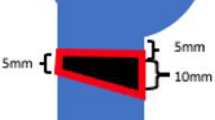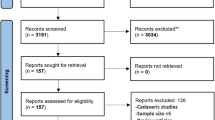Abstract
Introduction
Optimal treatment of high-risk ankle fractures in older, comorbid patients is unknown. Results of open reduction internal fixation (ORIF) versus tibiotalocalcaneal (TTC) fusion nailing for the treatment of high-risk geriatric ankle fractures were investigated.
Materials and methods
Results of ORIF versus TTC fusion nailing were evaluated via retrospective case–control cohort study of 60 patients over age 50 with an open ankle fracture or one with at least 50% talar subluxation and at least 1 high-risk comorbidity: diabetes mellitus (DM), peripheral vascular disease, immunosuppression, active smoking, or a BMI > 35. The primary outcome was reoperation rate within 1-year post-surgery. Secondary outcomes include infection, peri-implant fracture, malunion/nonunion, mortality, length of stay, disposition, and hospital acquired complications.
Results
Mean age was 71 (ORIF) and 68 (TTC). 12/47 (25.5%) ORIF cases were open fractures versus 4/14 (28.6%) with TTC. There were no significant differences between ORIF and TTC in 1-year reoperation rates (17% vs 21.4%), infection rates (12.8% vs 14.3%), or union rates (76.% vs 85.7%), respectively. One TTC patient sustained a peri-implant fracture treated nonoperatively. There were no significant differences in medical risk factors between groups other than a higher rate of DM in the TTC group, 42.6% vs 78.6%, p = 0.02. Incomplete functional outcome data in this challenging patient cohort precluded drawing conclusions.
Conclusion
ORIF and TTC fusion nailing result in comparable and acceptable reoperation, infection, and union rates in treating high-risk ankle fractures in patients over 50 with at least 1 major comorbidity for increased complications; further study is warranted.





Similar content being viewed by others
References
Court-Brown CM, Biant LC, Clement ND, Bugler KE, Duckworth AD, McQueen MM (2015) Open fractures in the elderly. The importance of skin ageing. Injury 46(2):189–194. https://doi.org/10.1016/j.injury.2014.07.021
Konopitski A, Boniello AJ, Shah M, Katsman A, Cavanaugh G, Harding S (2019) Techniques and considerations for the operative treatment of ankle fractures in the elderly. J Bone Joint Surg Am 101:85–94. https://doi.org/10.2106/JBJS.17.01658
Al-Nammari SS, Dawson-Bowling S, Amin A, Neilsen D (2014) Fragility fractures of the ankle in the frail elderly patient: treatment with a long calcaneotalotibial nail. J Bone Joint Surg Br 96B(6):817–822. https://doi.org/10.1302/0301-620X.96B6.32721
Amirfeyz R, Bacon A, Ling J, Blom A, Hepple S, Winson I, Harries W (2008) Fixation of ankle fragility fractures by tibiotalocalcaneal nail. Arch Orthop Trauma Surg 128:423–428. https://doi.org/10.1007/s00402-008-0584-z
Lemon M, Somayaji HS, Khaleel A, Elliott DS (2005) Fragility fracture of the ankle: stabilization with an expandable calcaneotalotibial nail. J Bone Joint Surg Br 87(6):809–813. https://doi.org/10.1302/0301-620X.87B6.16146
Aigner R, Salomia C, Lechler P, Pahl R, Frink M (2017) Relationship of prolonged operative time and comorbidities with complications after geriatric ankle fractures. Foot Ankle Int 38(1):41–48. https://doi.org/10.1177/1071100716667315
Rammelt S (2016) Management of ankle fractures in the elderly. EFORT Open Rev 1(5):239–246. https://doi.org/10.1302/2058-5241.1.000023
Zaghloul A, Haddad B, Barksfield R, Davis B (2014) Early complications of surgery in operative treatment of ankle fractures in those over 60: a review of 186 cases. Injury 45(4):780–783. https://doi.org/10.1016/j.injury.2013.11.008
Jonas SC, Young AF, Curwen CH, McCann PA (2013) Functional outcome following tibio-talar-calcaneal nailing for unstable osteoporotic ankle fractures. Injury 44(7):994–997. https://doi.org/10.1016/j.injury.2012.11.008
Toole WP, Elliott M, Hankins D, Rosenbaum C, Harris A, Perkins C (2015) Are low-energy open ankle fractures in the elderly the new geriatric hip fracture? J Foot Ankle Surg 54(2):203–206. https://doi.org/10.1053/j.jfas.2014.10.015
Basques BA, Miller CP, Golinvaux NS, Bohl DD, Grauer JN (2015) Morbidity and readmission after open reduction and internal fixation of ankle fractures are associated with preoperative patient characteristics. Clin Orthop Relat Res 473(3):1133–1139. https://doi.org/10.1007/s11999-014-4005-z
Davidovitch RI, Walsh M, Spitzer A, Egol KA (2009) Functional outcome after operatively treated ankle fractures in the elderly. Foot Ankle Int 30(8):728–733. https://doi.org/10.3113/FAI.2009.0728
Bariteau JT, Hsu RY, Mor V, Lee Y, DiGiovanni CW, Hayda R (2015) Operative versus nonoperative treatment of geriatric ankle fractures: a Medicare Part A claims database analysis. Foot Ankle Int 36(6):648–655. https://doi.org/10.1177/1071100715573707
Srinivasan CM, Moran CG (2001) Internal fixation of ankle fractures in the very elderly. Injury 32(7):559–563. https://doi.org/10.1016/s0020-1383(01)00034-1
Anderson SA, Li X, Franklin P, Wixted JJ (2008) Ankle fracture in the elderly: initial and long-term outcomes. Foot Ankle Int 29(12):1184–1188. https://doi.org/10.3113/FAI.2008.1184
Schray D, Ehrnthaller C, Pfeufer D et al (2018) Outcome after surgical treatment of fragility ankle fractures in a certified orthogeriatric trauma center. Injury 49:1451–1457. https://doi.org/10.1016/j.injury.2018.06.030
Olsen JR, Hunter J, Baumhauer JF (2013) Osteoporotic ankle fractures. Orthop Clin N Am 44:225–241. https://doi.org/10.1016/j.ocl.2013.01.010
Lynde MJ, Sautter T, Hamilton GA, Schuberth JM (2012) Complications after open reduction and internal fixation of ankle fractures in the elderly. Foot Ankle Surg 18:103–107. https://doi.org/10.1016/j.fas.2011.03.010
Shivarathre DG, Chandran P, Platt SR (2011) Operative fixation of unstable ankle fracture in patients over 80 years. Foot Ankle Int 32(6):599–602. https://doi.org/10.3113/FAI.2011.0599
Srinath A, Matuszewski P, Kalfac T (2021) Geriatric ankle fracture: robust fixation versus hindfoot nail. J Orthop Trauma 35(Suppl 5):S41–S44. https://doi.org/10.1097/BOT.0000000000002232
Panchbhavi VK, Vallurupalli S, Morris R (2009) Comparison of augmentation methods for internal fixation of osteoporotic ankle fractures. Foot Ankle Int 30(7):696–703. https://doi.org/10.3113/FAI.2009.0696
Zahn RK, Frey S, Jakubietz RG et al (2012) A contoured locking plate for distal fibula fractures in osteoporotic bone: a biomechanical cadaver study. Injury 43(6):718–725. https://doi.org/10.1016/j.injury.2011.07.009
Kim T, Ayturk UM, Haskell A, Miclau T, Puttlitz CM (2007) Fixation of osteoporotic distal fibula fractures: a biomechanical comparison of locking versus conventional plates. J Foot Ankle Surg 46(1):2–6. https://doi.org/10.1053/j.jfas.2006.09.009
Cinats DJ, Kooner S, Johal H (2021) Acute hindfoot nailing for ankle fractures: a systematic review of indications and outcomes. J Orthop Trauma 35(11):584–590. https://doi.org/10.1097/BOT.0000000000002096
Georgiannos D, Lampridis V, Bisbinas I (2017) Fragility fractures of the ankle in the elderly: open reduction and internal fixation versus tibio-talo-calcaneal nailing: short-term results of a prospective randomized-controlled study. Injury 48:519–524. https://doi.org/10.1016/j.injury.2016.11.017
Funding
There was no outside funding of this project.
Author information
Authors and Affiliations
Contributions
All authors contributed to the study conception and design. Material preparation and data collection were performed by TML, AMK, and HMF and analysis was performed by KRB. The first draft of the manuscript was written by TML and all authors commented on previous versions of the manuscript. All authors read and approved the final manuscript.
Corresponding author
Ethics declarations
Conflict of interest
On behalf of all authors, the corresponding author states that there is no conflict of interest.
Ethical approval
This study was performed in line with the principles of the Declaration of Helsinki. Approval was granted by the Institutional Review Board at Mission Hospital, Asheville, NC, USA: IRB Net #1139182-5, IRB Protocol #: 17-10-1745, NF. Data were analyzed and kept in a deidentified local network secured repository and is not publicly available.
Informed consent
Informed consent was obtained from all individual participants included in the study. The authors affirm that human research participants provided informed consent for publication of the deidentified images in Figs. 1, 2, 3, 4 and 5.
Additional information
Publisher's Note
Springer Nature remains neutral with regard to jurisdictional claims in published maps and institutional affiliations.
Rights and permissions
Springer Nature or its licensor holds exclusive rights to this article under a publishing agreement with the author(s) or other rightsholder(s); author self-archiving of the accepted manuscript version of this article is solely governed by the terms of such publishing agreement and applicable law.
About this article
Cite this article
Large, T.M., Kaufman, A.M., Frisch, H.M. et al. High-risk ankle fractures in high-risk older patients: to fix or nail?. Arch Orthop Trauma Surg 143, 3725–3734 (2023). https://doi.org/10.1007/s00402-022-04574-3
Received:
Accepted:
Published:
Issue Date:
DOI: https://doi.org/10.1007/s00402-022-04574-3




